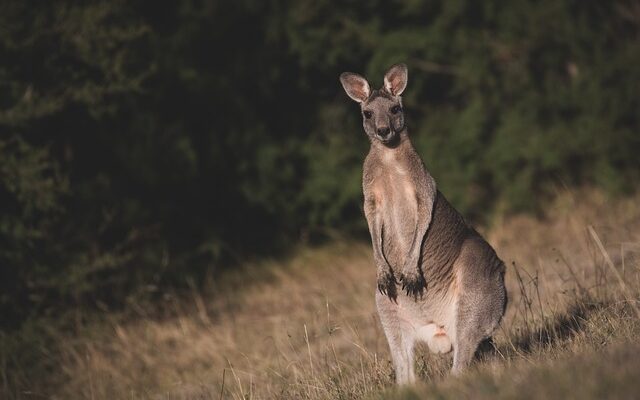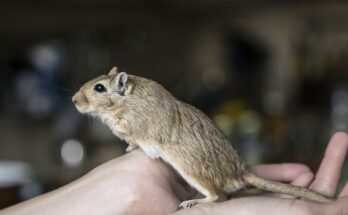Introduction:
Kangaroos are known for hopping on their muscular hind legs with their long tails extended backward. But these grazers spend much more time moving slowly than jumping quickly [1], and when they do, kangaroos use their tails very differently. They place it sequentially on the ground with their fore and hind legs in a characteristic gait known as a “pentapedal” movement [2,3], with the fifth point of contact being the tail.
Description:
“Discover the unique culinary and cultural significance of kangaroo tail with our comprehensive guide. From traditional Aboriginal cuisine to modern culinary explorations, learn about the flavors, preparation methods, and nutritional benefits of this iconic Australian delicacy.”
Use of tails:
This unique use of a tail has long been of scientific interest [3,5,6], and there is much speculation as to whether the tail functions as an extra leg during pentapedal locomotion [7–9]. Kangaroo tails appear to be biomechanically and physiologically powerful structures: the tail muscles are much larger than the forelimb muscles and they are densely populated with mitochondria, indicating a large aerobic capacity [10]. However, the anatomy of the kangaroo tail is very different from the front and back legs: it consists of more than twenty tail vertebrae instead of a few long bones [11]. The highly articulated anatomy of tails is not usually associated with leg-like behavior, but rather with grasping or balancing functions [12–14]. The ancestors of today’s kangaroos lived in trees [15,16] and therefore probably used their tails for support and balance. Here, we use biomechanically meaningful measurements to quantitatively test whether kangaroos.
Materials and methods:
(a) Experimental setup:
We trained five red kangaroos (Macropus rufus) to “walk” on five legs across a force-measuring platform while filming their movements. Four adult females walked along a walkway over a submerged built-in platform. Force plate (Kistler 9281A) that recorded vertical and anteroposterior forces at 1000 Hz.
(b) Video Analysis:
From the video recordings, we determined the time when the front legs, hind legs, and tail made contact with the ground. We limited our analysis to a single velocity range used consistently by all animals (0.63–0.88 m s−1). We also eliminated trials with irregular limb contact moments and trials with significant acceleration (|net fore-aft acceleration| > 0.4 m s−2) (see also the electronic supplementary material).
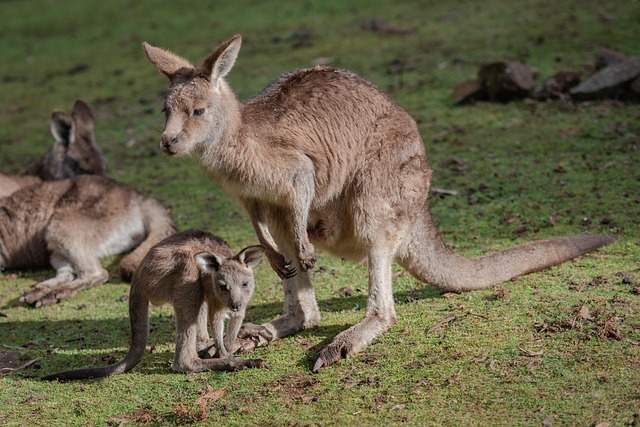
(c) Analysis of limb forces
We analyzed trials in which the limbs contacted the force platform in a way that allowed us to separate the ground reaction forces (GRFs) generated by the forelimbs, hindlimbs, and tail. We then estimated the overall result of a consensus run for each animal. The mean forces on the tail, the forces on the front legs, and the forces on the hind legs are added together. A total of 22 trials with a mean speed of 0.77 ± 0.07 m s−1 (mean ± standard deviation) were used for the final analysis.
(d) Estimation of force generated by limbs:
We used established methods to estimate the force produced and the work done by each limb for each animal ([17]; see also the electronic supplementary material).
Results:
We found that kangaroos use their tail as a very powerful leg for five-legged locomotion. The tail exerts very little braking force but produces a large propulsive force—as much as the front and hind legs combined (p = 0.08, paired t-test). The only role previously attributed to the tail in the pentapod was to support the weight of the body. 3.5]. Indeed, we see that the tail exerts a significant vertical force on the ground, although it only contributes 13.6 ± 1.0% (mean ± standard deviation) to the average vertical force required to support the body during a step. However, the support function of the tail is more pronounced when the hind legs are not in contact with the ground and exert an average vertical force of 36.2 ± 2.6% of body weight during this period.
Although the hind legs were responsible for the majority of the positive mechanical work (72.9 ± 15.7%), the role of the tail was significant (22.1 ± 15.2%). Per kilogram of body weight, kangaroos did as much positive work with their tail (0.17 ± 0.10 W kg−1) as humans did with one of their legs when walking at the same speed [17].
Discussion:
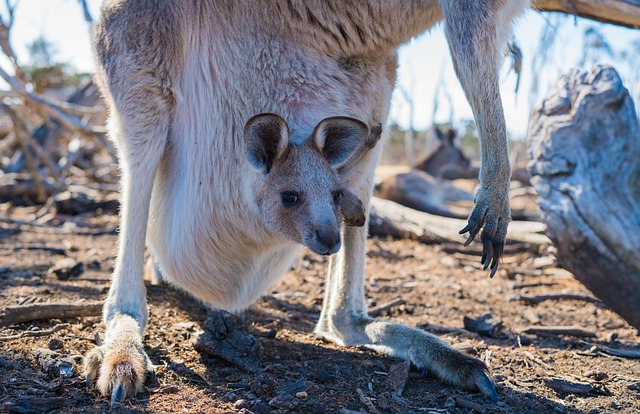
Kangaroo tails appear to function biomechanically similarly to a leg during pentapedal locomotion. This means they push down on the ground regularly to provide meaningful body weight support, propulsion, and strength. This biomechanical definition measures bone-like behavior by its functional role, regardless of a limb’s primary use, its location in the body, or its evolutionary history.
Kangaroo tails have evolved significantly from the prehensile role they played in arboreal ancestors of modern land kangaroos [15]. Although the most obvious role of the kangaroo tail at present is to provide a counterweight to the body during jumping [4], another role has emerged during walking. Kangaroos do not waste the biomechanical resources of the tail when moving slowly. Instead, they use this muscular appendage as an extra leg to support, propel, and strengthen their movement.

Acknowledgments:
We thank Andrew McIntosh for providing equipment, Suzette Rodoreda for animal training, Alena Grabowski for video analysis, and John Hutchinson for helpful comments.
Data Availability:
Individual kangaroo kinetics data were uploaded as electronic supplementary material.

Funding overview:
Supported by an NSERC Discovery Scholarship, an ISB Travel Scholarship, and a JEB Travel Scholarship for J.M.D. and in part from the Australian Research Council (grant number A19917218) to T.J.D.
Advantages:
Kangaroo tail, often considered a delicacy in some cultures, offers several advantages:
Nutrient-rich: Kangaroo tail is a good source of essential nutrients such as protein, iron, and zinc. It provides a lean and healthy meat option compared to some traditional meats.
Low in fat:
Kangaroo tail is relatively low in fat, making it a healthier choice for individuals conscious of their dietary fat intake.
Sustainability: Kangaroo meat is often considered a more sustainable choice compared to some other meats, as kangaroos are abundant in certain regions of Australia. Their population management is regulated to prevent overgrazing and maintain ecological balance.
Cultural significance:
In some Indigenous Australian cultures, kangaroo tail holds cultural significance and is considered a traditional food source. Consuming kangaroo tails can be a way of honoring and preserving these cultural practices.
It’s important to note that while there are advantages to consuming kangaroo tail, ethical and environmental considerations should be taken into account. Sustainable and responsible sourcing practices are crucial to ensure the long-term health of kangaroo populations and ecosystems.
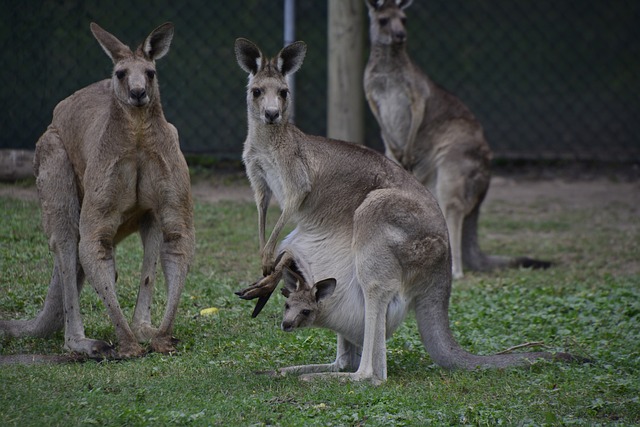
FAQS:
Not only does a red kangaroo use its tail to help walk and balance, but it also conserves important energy. The tail’s anatomy boasts large muscles (which cover all those vertebrae) similar in power to those used by the human leg while walking.
They help maintain tooth and gum hygiene as they require a lot of chewing and gnawing. We recommend these as an outdoor treat as they can crumble off a lot – though the dogs will make sure there is no evidence left over.
Kangaroo tastes very much like venison — a very lean meat and slightly gamey. It goes very well in rich, slow-cooked casseroles (in which case, you might not realize that it isn’t beef), but is often simply seared and served as rare steak. If you ask for medium, it will be tough because its fat content is so low.
Kangaroo tails appear to function biomechanically just like a leg during pentapedal locomotion. That is, they periodically push on the ground to provide meaningful body-weight support, propulsion, and power.
A study in this week’s Biology Letters says that a walking kangaroo propels itself with its tail, essentially transforming the appendage into a fifth “leg.” The study found that the tail of a walking kangaroo works as hard as the leg of a comparably sized human strolling at the same speed.

